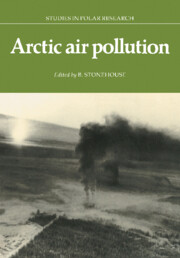Book contents
- Frontmatter
- Contents
- CONTRIBUTORS TO THIS VOLUME
- FOREWORD
- INTRODUCTION: INTERNATIONAL SYMPOSIUM ON ARCTIC AIR POLLUTION
- Part 1 Composition, source areas and transport pathways
- Part 2 Local, regional, global, ecological and climatic implications
- Part 3 Health and ecological issues
- Part 4 International cooperation and state responsibility
- The impact of human and industrial activities on the Arctic environment: legal considerations and international liabilities
- Cooperation of China, Japan and United States in the study of long-range aerosol transport to the Pacific and Arctic
- International scientific cooperation in the Arctic: problems, opportunities and US responsibilities
- Arctic haze and bush Alaskan villages
- Arctic air pollution and Alaska's concerns
- Modern life systems of indigenous people of bush Alaska
- 5 Conclusions
- Index
Modern life systems of indigenous people of bush Alaska
Published online by Cambridge University Press: 03 May 2010
- Frontmatter
- Contents
- CONTRIBUTORS TO THIS VOLUME
- FOREWORD
- INTRODUCTION: INTERNATIONAL SYMPOSIUM ON ARCTIC AIR POLLUTION
- Part 1 Composition, source areas and transport pathways
- Part 2 Local, regional, global, ecological and climatic implications
- Part 3 Health and ecological issues
- Part 4 International cooperation and state responsibility
- The impact of human and industrial activities on the Arctic environment: legal considerations and international liabilities
- Cooperation of China, Japan and United States in the study of long-range aerosol transport to the Pacific and Arctic
- International scientific cooperation in the Arctic: problems, opportunities and US responsibilities
- Arctic haze and bush Alaskan villages
- Arctic air pollution and Alaska's concerns
- Modern life systems of indigenous people of bush Alaska
- 5 Conclusions
- Index
Summary
The Alaskan native people have gone through a great deal of change within the last two generations. Their remote location in the Arctic no longer isolates them from the modern world. Natural resources of the Bush—fish and other forms of wildlife, locatable and leasable minerals, and tourists attracted to the Bush way of life (called ‘subsistence’)—have all brought change to the way that people live, and the air, lands and waters they live with and depend on.
The majority of Alaskan native people still live a hunting-gathering way of life. They do not sit in office buildings. They do not wear coats and ties. They do not work eight hours a day. However, the modern world of the Alaskan native does include labour for cash. Our villages are no longer self-sufficient. Framed houses have replaced the sod houses built with drift wood. Our villages now require imported energy for space heating and electricity production. We watch television from New York, and see new movies from Hollywood right in our homes.
Zimbabwe in south central Africa is now very important to us. Why would Bush Alaskan natives care about that place? Zimbabwe produces cobalt. We need cobalt to produce hard alloys for our snow machines and outboard engines, to get us to remote locations to harvest the food we eat.
Even with all these modern luxuries, we still need wildlife resources. The harvest of wildlife is the key to our culture and to the maintenance of our health.
- Type
- Chapter
- Information
- Arctic Air Pollution , pp. 307 - 308Publisher: Cambridge University PressPrint publication year: 1987



